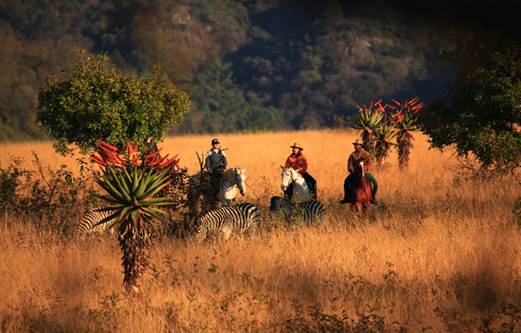Mkhaya Game Reserve
This private, upmarket reserve offers
Swaziland's most exclusive safari experience. Among the big game reintroduced
to their former habitat here are elephant, buffalo, giraffe, hippo, white rhino
and rare black rhino. Guided game drives offer close-up viewing, and this is
one of Africa's best locations for tracking rhino - including black rhino - on
foot. There are no big cats, but spotted hyenas prowl the darkness. The smaller
wildlife includes a wealth of birds. Explore Stone Camp for treats such as suni
and pink-throated twin spot.

Nyala
(Tragelaphus angasi) standing over her baby at Mkhaya Game Reserve
Right Time, Right Place
Choosing when to visit comes down more to
personal priority than practicality. Most roads are navigable all year round
and few attractions are strictly seasonal. The climate varies from temperate in
the western high veld, where winter (June-August) can be freezing at night; to
sub-tropical in the eastern low veld, where summer (Nov-Feb) can top 40°C. The
rainy season is roughly October-April, but is not as clearly defined as further
north in Africa, with rain possible at any time in the high veld.

enjoy
Swaziland's natural heritage
Summer brings dense mists in the hills and
violent electrical storms everywhere. Wildlife watchers will not find the same
peak/off-peak seasonal pattern of many safari destinations, as Swaziland's
parks are small enough to find the game year round. The rainy season brings a
richer general wildlife experience, with migrant birds joining resident species,
reptiles out and about, and the high veld flora in bloom. In general, unless
you aim to attend one of Swaziland's key festivals (dates below), there is no
wrong time to visit.
Find out more
Language
SiSwati and English (English is widely
spoken and the medium of instruction in schools).

And
Find out more
Time zone
South African Standard Time (UTC +2)
International dialling code + 268
Visas
Visas are not required by nationals of the
UK, USA, Australia, Canada, South Africa, British Commonwealth countries and EU
countries.
Health
Check you are up-to-date with your jabs.
Most authorities advise that eastern Swaziland is malarial; in fact, the
disease has effectively been eradicated , but take advice and err on the side
of caution. Travellers arriving from countries where yellow fever occurs may
need to show proof of vaccination.
Safety
Swaziland is in general a safe place in
which to travel. But avoid poorly lit urban areas after dark and be careful on
the roads. Don't drive at night.
Money
The unit of currency is the Lilangani (SZL;
plural Emalangeni), which has parity with the South African Rand (ZAR). Rand
are accepted in Swaziland but not Emalangeni in South Africa. Recent exchange
rates were US$1 = 8.18SZL. Credit cards are widely accepted and all towns have
ATMs.
Costs
Budget travellers could manage on $30 per
day by camping and taking local transport. A modest mid-range budget, including
hotels, restaurants and most activities could be $114-152 per day. Allow more
for specialised activities (eg: $91 for a half-day's white-water rafting,
including lunch and transfers). Economy car hire available from $168 per week.
Getting there
You can reach Swaziland by air only from
Johannesburg on Airlink (www.flyswaziland.com), which flies daily to Matsapha
International Airport (aka Manzini). Most major international airlines fly to
Jo'burg. Alternatively, drive through any of 13 border posts; the main
Oshoek/Ngwenya border is 3.5 hours from Jo'burg.
Getting around
Nowhere in Swaziland is much more than two
hours' drive on good roads from Mbabane. Local buses run between all towns. Car
hire is available in Mbabane, at the airport or in South Africa.
Books
Swaziland is criminally neglected by major
guidebook publishers, appearing generally only as one chapter in a larger guide
to South Africa. Bradt's Swaziland guidebook (1st ed, 2012) by Mike Unwin is
due out in December. Good books available locally include A Traveller's Guide
to Swaziland by Bob Forrester (2009, Kamhlaba Publications) and Swaziland by
David Fleminger (2009, Southbound Travel Guides). For natural history, try Wild
Swaziland by R Boycott et al (2007, P&J Perry). For entertainment, try The
Wah Wah Diaries by Richard E Grant (2006, Picador), in which the actor
describes making a film about his Swazi childhood.
Find out more
Swaziland Tourism London (www.theki ngdom
ofswazila nd.com)
With thanks
Mike Unwin travelled courtesy of Kenya
Airways (www.kenya-airways.com) and Airlink (www. flyswazi la nd.com).
(Travel Africa UK Summer – 2012,
102-105)